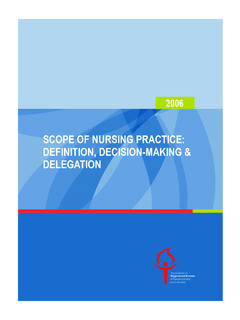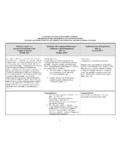Transcription of Communication: A Dynamic Between Nurses and Physicians T
1 November-December 2012 Vol. 21/No. 6385 Cassandra Lee Flicek, BSN, RN, CMSRN,is Staff nurse , Medical-Surgical Unit, Thoracic/Respiratory, Mayo Clinic, Rochester, : A Dynamic BetweenNurses and PhysiciansThe status of health care is a leading topic for dis-cussion in the United States today. Importantly,consumers demand quality health care; there-fore, health care professionals need to providehigh-quality, safe, effective health care while loweringcost. One main component to delivering this service suc-cessfully is effective communication . Communicationprevents costly errors, streamlines patient care to preventdelays, and demonstrates a united front among membersof the health care team (Schmalenberg & Kramer, 2009).While Nurses and Physicians as key members of thehealth care team facilitate quality care, many studiesshow breakdown in nurse - physician communicationremains a concern.
2 According to The Joint Commission(Woods, 2006), nearly 60% of medical errors are a directresult of communication education and clinical placement received byphysicians and Nurses during prelicensure training con-trast greatly and have been an influential element incommunication breakdown Between the two professions(Dixon, Larison, & Zabari, 2006). During the pre-licensurestages for the two professions, emphasis is placed on theirindividual roles in patient care. The lack of co-education-al experiences involving the two professions possiblyleads to a lack of understanding of what each professioncontributes to the interdisciplinary team, and compli-cates communication Between Nurses and , Gorman, Slimmer, and Yudkowsky (2010)noted Nurses believe Physicians do not view them as pro-fessionals but simply purveyors of tasks (p.)
3 214). Nursesattribute this belief to their perception that Physicians arenot always knowledgeable of Nurses scope of practiceand the autonomy Nurses have earned. According toDixon and co-authors (2006), Physicians express frustra-tion with Nurses communication style, describing it as disorganization of information, illogical flow of content,lack of preparation to answer questions, inclusion ofextraneous or irrelevant information, and delay in gettingto the point (p. 377). Clearly, each professional groupperceives the other to be the primary culprit in commu-nication indicates Physicians must inform themselvesof the scope of practice and knowledge Nurses can con-tribute to patient care. Likewise, Nurses must understandthe unique problem-solving process used by physiciansand provide information in a timely, accurate manner(Tschannen et al.
4 , 2011). Nurses should be assertive inadvocating for patient needs so Physicians clearly under-stand the primary issues in order to take appropriateaction to correct patient concerns or problems(McCaffery et al., 2011).BarriersIn addition to each profession s potential perceptionsof the other, multiple barriers exist that hinder nurse - physician communication . A continuous flow of inter-ruptions and multiple patient handoffs affect the abilityof Nurses and Physicians to connect effectively, and estab-lish a trusting and collegial relationship (Tschannen et al.,2011). Time is also a major factor in communicationbreakdown. Because Nurses and Physicians can be inde-pendently busy, finding time to communicate properlybecomes a pressing issue (Burns, 2011).
5 Work environ-ments characterized by high patient acuity and staffingshortages create additional stress and thus contribute tocommunication breakdown. Even sex disparity amonghealth care team members can create a barrier to effectivecommunication (Fernandez, Tran, Johnson, & Jones,2010). Males tend to prefer clear, quick, fact-based com-munication, while females prefer a more in-depth discus-sion style that attempts to understand the reason foroccurrences (McCaffrey et al., 2011). Advances in technology implemented to increasequality and efficiency have a part in communicationbreakdown as well. communication modalities, such astext pagers, patient inbox messaging, and electronicordering systems, can contribute to increased errors.
6 Useof these methods may misrepresent the urgency or thetone of the communication received; due to equipmentmalfunction, a message may not be received at to Robinson and colleagues (2010), Nurses andphysicians express a desire to follow up on urgent ordersor electronic messages with some form of verbal Practice SolutionsMany strategies have been developed to address nurse - physician communication breakdown. Implementationof unit-based care teams places Physicians and nursesProfessionalIssuesCassandra Lee FlicekNovember-December 2012 Vol. 21/No. 6386close to each other, increasing opportunities for improvedcommunication (Gordon et al., 2011). Mandatory bed-side rounds also have been shown to promote effectivecommunication, creating greater satisfaction for thepatient and members of the health care team.
7 Increasedsatisfaction occurs because Physicians , Nurses , andpatients participating in bedside rounds receive the sameinformation to accomplish their tasks and meet patientcare goals (Burns, 2011). Including patients and theirfamilies in bedside rounds provides opportunity for directdialogue that reduces the occurrence of miscommunica-tion regarding the plan of care and allows patients tobecome active members of the health care team. If theplan of care is not understood by all team members, cohe-sive care is not accomplished and the opportunity toachieve patient care goals can be missed (O Leary et al.,2010).Utilization of the SBAR tool has gained popularity inhealth care. Provision of the situation (S), background (B),assessment (A), and recommendations (R) has proven tobe effective in nurse - physician communication .
8 Communicating in the SBAR format allows each disci-pline to give and receive vital information in a way thatsatisfies varying communication styles and needs (Dixon et al., 2006, p. 380). Less common solutionsinclude implementation of a formal resident orientationto the patient care unit (Quisling, 2009). Research hasfound pairing a new resident on the unit with a nurse fora designated amount of time clarified to the physiciannurses unique contribution to healthcare and under-scored the importance of collaboration (Booth, 2010, ). Furthermore, Nurses perceived Physicians were moreinformed about the nursing role and felt a higher level ofcomfort communicating with Physicians when thismethod was applied. Improvement in the coordinationof care is apparent when a trusting relationship is present(Quisling, 2009).
9 Author s Clinical ExperienceThe author works as a registered nurse on a medicalrespiratory unit in a large teaching hospital in the mid-western United States. During a unit council meeting in2011, many Nurses on the unit expressed a desire toimprove communication with the Physicians by the nextyear. Use of the SBAR tool had been implemented prior tothe unit council meeting was expected among caregivershospital wide. This tool has helped communication , espe-cially during hand-off Between patient care units and dur-ing acute situations that require intervention. However, Nurses on the author s unit recognized the need for morestrategies to improve communication in addition to theSBAR rounds have been implemented with a medi-cine service assigned to the author s unit, with a promptcard used to guide discussion of critical elements ofpatient care, such as pain, mobility, safety, fluid reconcil-iation, and discharge plans.
10 When Physicians from themedicine service arrive at a patient s room, they page theprimary RN to attend bedside rounds. The assigned nurseProfessional Issuesis identified with a picture posted near the patient s door,and his or her pager number is provided on the door this method worked initially, it now is utilizedinconsistently. Barriers to effective use of this modelinclude the availability of Nurses and high patient acuity,in which some patient needs may take priority over bed-side rounds. In addition, frequent change occurs in physi-cian residents who staff the medicine service, and newresidents are unfamiliar with the unit solution to ineffective communication on the unitis implementing the process of mandatory multidiscipli-nary bedside rounds.








